The world is a big, wonderful place full of facts we never thought possible. For instance, if a pregnant mouse has a sudden medical issue, the fetus will send stem cells to heal the mother, increasing its chances of survival as well. Fetal stem cells have been found in human mothers as well, dubbed by science as microchimerism.
Bright Side dug up some more marvelous facts about nature and its creations, upholding our yearly resolutions to spread knowledge and joy.
1. The heart slows when your face touches water.
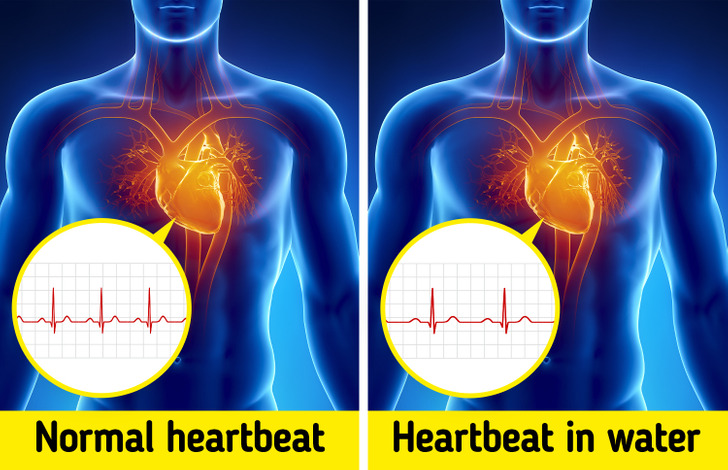
As mammals, we can’t breathe underwater, so as part of the mammalian dive reflex, our heart rate goes down in the water — more so if we go underwater. Even splashing the face with water makes the heart slow down, making it a great way to calm down.
2. Fungus can break down plastic in weeks.
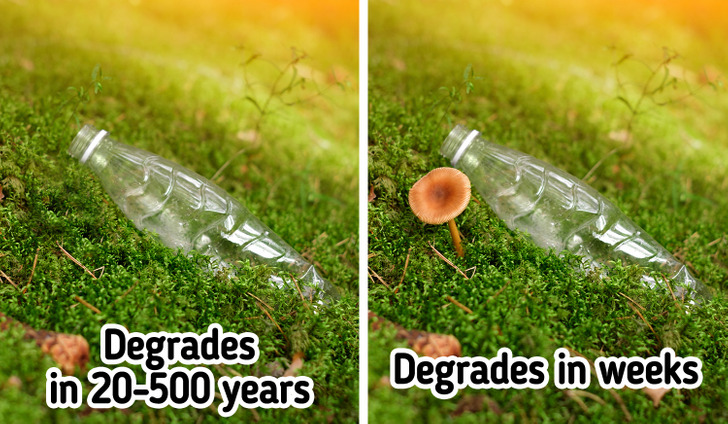
It is said that in the future, there may be more plastic in the ocean than fish. This is why the plastic-eating fungus is great news, and there are around 50 new species of such fungi discovered already. One of the fungi discovered can digest plastic within 2 months, so there’s hope for us yet.
3. Newborn babies can support their own weight.

Newborn babies are strong — strong enough to be able to grasp things in their tiny fists and even support their weight as shown by an experiment done in the nineteenth century. Louis Robinson witnessed babies able to hang from a walking stick, from 10 seconds to 2 minutes and 35 seconds.
4. Koala fingerprints have been mistaken for human ones.
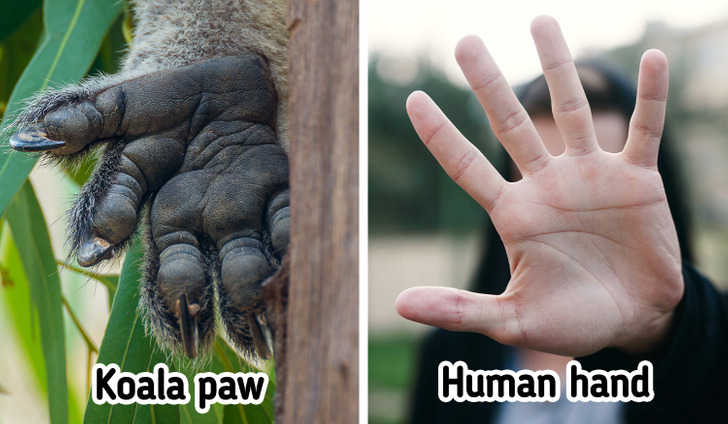
We’ve been told that our fingerprints are unique, and they are. But the fact remains that even though we share a common ancestor with the koala that was alive 100 million years ago, koala fingerprints look very similar to human fingerprints, as do chimpanzee fingerprints for that matter.
5. Snails can sleep for 3 years.
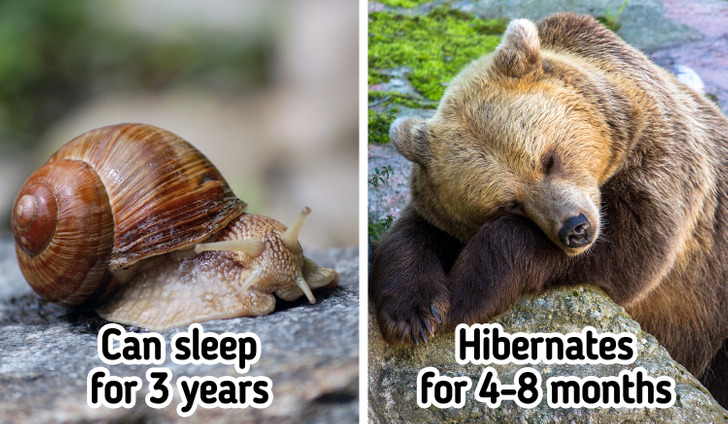
If you thought bears had it good with hibernation, meet the snail. Snails can sleep rather than hibernate for 3 years at a time without needing food. Of course, this is with some snail species, not all of them. Meanwhile, bears usually hibernate for just 4-8 months.
6. Sloths need 2 weeks to digest food.
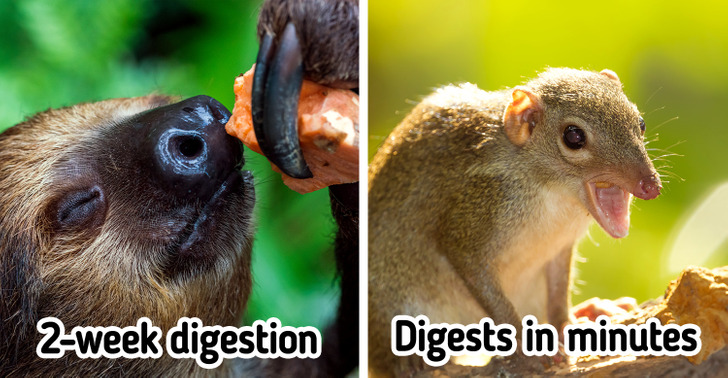
Sloths don’t only move in slow motion — even their insides move slowly, ostensibly to preserve energy, which is why a sloth’s digestive system takes 2 weeks to process the food it ate. Plus, most of what it eats is indigestible, giving it very little energy from each slowly chewed mouthful.
On the other end of the spectrum lies the shrew, whose digestion takes mere minutes and is done so fast, not much of it is fully digested. This is the reason why shrews eat their own feces. They can die of starvation in a matter of hours if they don’t eat.
7. Your brain ignores seeing your nose.
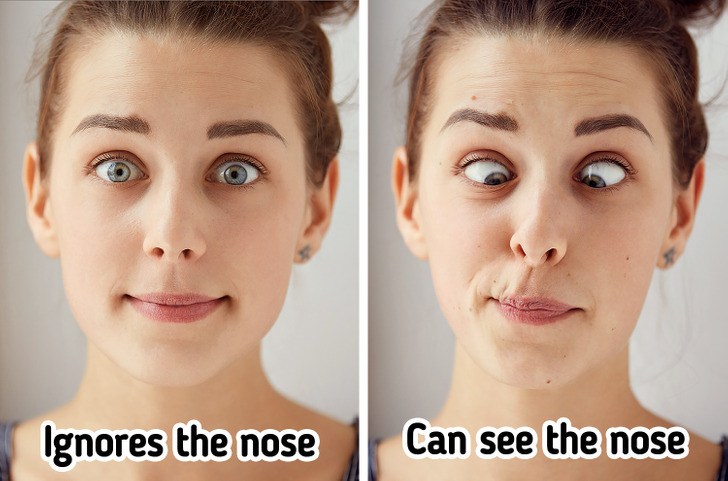
We can see our nose all the time, it’s just that the brain tends to ignore it because it’s a constant visual stimulus. It’s the same with people who wear glasses. After a while, they simply stop noticing them.
8. Your forearm is the same length as your foot.

If you don’t have the time to try on a shoe, measure it from your elbow crease to your wrist. If it fits or is just a little smaller, it would fit your foot because the length of your forearm is the same as your foot. And this is just one of many human body ratios that are a marvel in themselves, including the fact that your femur bone is one-quarter your height.
9. You can “see” your white blood cells.

If you look up at a cloudless, bright blue sky and see some wiggly things at the periphery of your vision, you’ve just experienced the blue field entoptic phenomenon. The wiggly things are white blood cells moving in the fine blood vessels moving in front of the retina, at the back of the eye.
10. Human beings have striped skin, but only cats can see it.
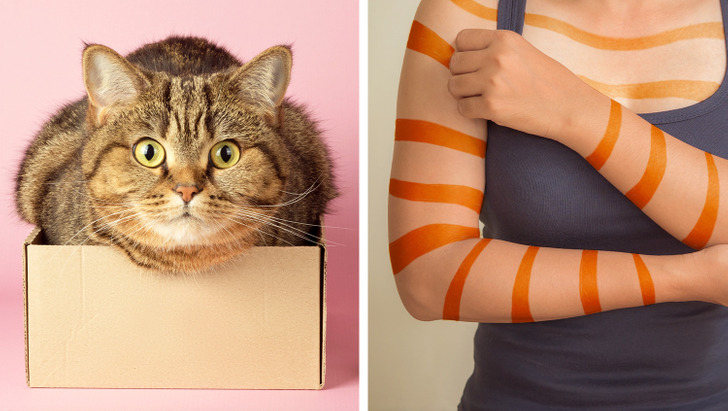
Human beings have stripes and patterns on the skin too, and they are called Lines of Blaschko, name eponymously by the scientist who discovered them, Dr. Alfred Blaschko. These are closer to tiger stripes, forming more of a V-pattern fanning out from the center to the extremities. These lines are visible under UV light, a spectrum that cats can see too, which is why cats can see you as a striped being as well.
Which of these facts turned out to be a revelation for you? Share your extreme nature facts with us and blow us away.
Preview photo credit Shutterstock.com, Shutterstock.com
My Son’s Teacher Called Me and Said, ‘I’m Sorry, but I Have to Tell You the Truth About Your Son and Your Husband’

I always thought the worst kind of betrayal came from strangers. I was wrong. It comes from the people you trust the most—the ones you’d never suspect. And in my case, it started with a phone call that changed everything.
I will never forget the day my world cracked open.
If you looked at us from the outside, you’d think we were a normal, happy family. I’m 38, a working mom who balances deadlines and dinner prep, school meetings, and Saturday movie nights.

A woman cooking for her family | Source: Pexels
My husband, Daniel, is 42—a dependable man, or so I thought. We’ve been together for 17 years, built a life, a home, and raised our only child, Dylan, who just turned 15.
Dylan has always been a quiet kid, more into books and video games than sports. He takes after me in that way—reserved, a little awkward, but with a heart of gold. Lately, though, something has been… off.
He’s been distant and withdrawn. He doesn’t laugh at our inside jokes anymore, and whenever I ask him how school was, all I get is a vague “fine” before he disappears into his room.

A sad teenage boy | Source: Pexels
At first, I thought it was just teenage mood swings. But then Daniel started acting strangely too. He’s been coming home later than usual, making excuses about work, his phone always buzzing with messages he quickly hides.
I tried convincing myself it was nothing—I mean, we’ve been married for almost two decades. But the tension in our house was thick, unspoken like we were all keeping secrets from each other.
Then, the phone call came.

Woman receiving a phone call | Source: Pexels
It was Dylan’s teacher, Mrs. Callahan. Her voice trembled through the receiver.
“I’m sorry, but I have to tell you the truth about your son and your husband.”
My stomach dropped. What truth?
My hands trembled as I held the phone to my ear. Mrs. Callahan’s voice was low, hesitant like she was afraid to speak.
“I—I need to see you in person,” she stammered. “There’s something I can’t keep from you anymore.”
My pulse quickened. “Is Dylan okay?”
A long pause.

Woman receiving a phone call | Source: Pexels
“Please, just meet me at the school,” she said, her voice almost pleading. “I’ll explain everything then.”
The call ended, but my mind raced. What could she possibly know? What did she mean by the truth? My gut twisted with unease, but I grabbed my keys and headed out.
When I arrived at the school, Mrs. Callahan was already waiting in her classroom, hands clenched together. She looked anxious, her usual warm demeanor replaced with something heavy—guilt, maybe?
“Mrs. Callahan, what’s going on?” I asked, my voice sharper than I intended.

A class teacher discussing a student’s behavior with a concerned parent | Source: Midjourney
She took a deep breath, her eyes darting toward the closed door as if making sure no one else could hear.
“A few days ago, I was walking past one of Dylan’s classmates’ houses,” she started, choosing her words carefully. “Kelly’s house, to be exact.”
My brow furrowed. “Kelly? Dylan’s friend?”
She nodded. “Yes. I saw Dylan and Kelly standing outside, near the driveway. I went up to say hello, but… something was off. They looked—nervous, on edge. Like they didn’t want me there.”

Two nervous teenagers | Source: Midjourney
I frowned. Dylan had been acting strange lately, but this? What was he hiding?
“And then I saw it.” Mrs. Callahan’s voice dropped to a whisper. “Your husband’s car. It was parked right in front of Kelly’s house.”
My stomach flipped. “Daniel’s car?”
“Yes. And when I looked through the window…” She hesitated as if deciding whether to continue. “I saw him. Your husband. He was inside, hugging Kelly’s mother.”

Couple hugging | Source: Pexels
The words hit me like a slap. I felt the air leave my lungs.
I shook my head, trying to process it. “You mean… like a friendly hug?”
Mrs. Callahan’s expression told me everything.
“No,” she said softly. “It wasn’t friendly. It was… intimate.”
The room tilted. My vision blurred.
Dylan knew. That’s why he was acting strange. He had seen it too.

People hugging | Source: Pexels
I sat there, frozen, my mind struggling to grasp what Mrs. Callahan had just told me.
“No,” I whispered, more to myself than to her. “That’s not possible.”
But deep down, I knew.
The late nights, the secrecy, the tension in our house—it all made sense now. Daniel wasn’t just distant; he was cheating. And the worst part? Dylan knew. My son had been carrying this secret, and I had been too blind to see it.

Concerned mother speaking with her son’s teacher | Source: Midjourney
I drove home in a daze, my knuckles white against the steering wheel. When I walked into the house, Daniel was on the couch, scrolling through his phone like nothing had changed.
“We need to talk,” I said, my voice shaking.
He looked up, uninterested. “Can it wait?”
“No.”
I told him everything—what Mrs. Callahan saw, what I knew. For a second, just a brief second, I saw something flicker in his eyes. But then, just as quickly, he smirked.

A man with a playful grin, relaxing on the couch | Source: Midjourney
“So what?” he said, shrugging. “It was bound to come out eventually.”
I wanted to scream, to throw something, to make him feel the pain he had just so casually inflicted on me. But I didn’t. I simply turned, walked upstairs, and started packing.
The divorce papers were filed within days. I thought Dylan would understand, that he’d be on my side. But when I told him, his face darkened.
“You’re overreacting,” he snapped. “Dad loves her. Just like I love Kelly.”

Woman talking to her teenage son | Source: Midjourney
My breath caught. What?
“Dylan…” I whispered, my stomach twisting.
“Yeah, Mom.” His eyes were cold. “We’re together. You want to tear this family apart because you can’t handle the truth? Fine. But I’m not leaving Dad.”
And just like that, my son—my baby—walked out the door and chose his father.
The house was empty. Too quiet. Too hollow.

A sad woman holding back tears | Source: Midjourney
For weeks, I drifted, barely functioning. The betrayal cut so deep that even breathing felt like a chore. I had lost my husband and my son in one blow.
Then one evening, as I left the grocery store, I heard a voice behind me.
“Hey, need a hand?”
I turned to see Mark—a single father to one of Dylan’s classmates. We had spoken a few times at school events, but I never thought much of him. Now, he was smiling at me, a gentle warmth in his eyes.
I forced a polite smile. “I’m fine, thanks.”

A man and a woman chatting outside a grocery store | Source: Midjourney
But Mark didn’t give up. Every now and then, he’d find an excuse to talk to me, invite me for coffee, check-in. At first, I ignored it—I wasn’t ready. But slowly, something in me softened.
If you had told me two years ago that my life would turn out like this, I would have laughed in your face. Back then, I was drowning in betrayal, abandoned by the two people I loved the most. I thought I’d never recover. But life has a way of surprising you.
Mark was patient. He never pushed, never demanded. He was just there—steady, kind, everything Daniel never was. What started as casual coffee meetups turned into long evening walks, shared laughter, and eventually, something I thought I’d never feel again: love.

A loving couple sharing a warm hug | Source: Pexels
Now, I’m married to him. And in a few months, we’ll be welcoming our baby into the world.
But Daniel? His perfect little fantasy didn’t last long.
Turns out, Kelly’s mother—oh, sweet, manipulative Julia—wasn’t in love with him. She was in love with his bank account. She drained him dry, took everything she could, and then vanished. The man who once smirked at my pain was now broke, bitter, and alone. Poetic justice.
And Dylan?
My son showed up at my door six months ago, eyes hollow, shoulders slumped.

A boy standing at the front door as his mother opens | Source: Midjourney
“Mom… I was wrong.”
He didn’t need to say more. I pulled him into my arms, holding him tight, feeling the weight of all the lost time between us. I wanted to be angry, to make him earn my forgiveness, but he was my son. And I had missed him more than words could express.
He moved back in with me and Mark, slowly mending what had been shattered. Some wounds take time, but we’re healing, together.

A teenage boy in deep thought | Source: Midjourney
And as I sit here now, rubbing my growing belly and watching Dylan set the dinner table with Mark, I can’t help but chuckle at the insanity of it all.
“What’s so funny?” Mark asked, wrapping his arms around me.
I shake my head, smiling. “This whole mess. It’s such a complicated story that happened within one school class.”

A happy expectant woman sitting on a porch with a man | Source: Midjourney



Leave a Reply